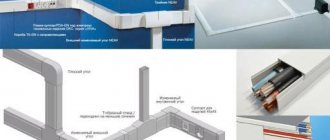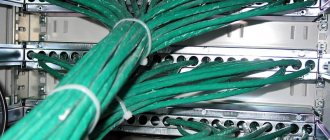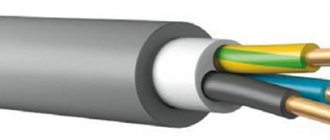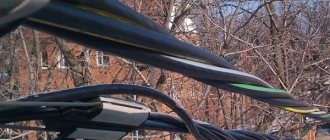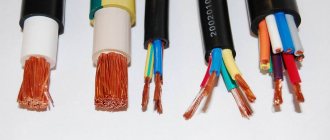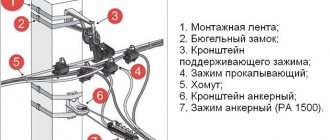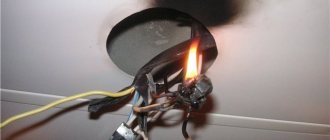When designing internal electrical wiring for residential and industrial premises, one of the key issues is the choice of cable products. Electricians and home craftsmen often wonder which cable is better to choose - NYM or VVGng, because both options are considered the most popular brands of cable products used for installing internal wiring of houses and apartments. The following comparative characteristics and features of the use of products of these brands will help you find the answer to all your questions.
Application area
NYM cable can be used in various climatic zones, inside production facilities with low or high humidity levels, in domestic and living rooms and even outdoors.
When installing outdoors, it is important to avoid direct exposure to ultraviolet rays of the sun. Inside residential buildings, wire is used in different cases: both with open and hidden wiring. It is used to switch lighting equipment, electrical sockets, switches and other devices. When installing a line in open ground, the cable must be protected using corrugated pipes or special boxes. When laid aerially, NYM is reinforced with high-quality overpasses. For any electrical devices that require a seal at the input, it is best to use just such a cable.
Differences in the field of application of cables according to fire hazard
The scope of application of cables for fire hazard is given in GOST 31565-2012 “Cable products. Fire safety requirements."
This GOST 31565 applies to cable products that are subject to fire safety requirements, intended for installation in buildings and structures, and establishes classification, fire safety requirements, and preferred areas of application. GOST 31565 does not apply to cable products intended for installation in land and water, as well as to oil-filled cables, winding and bare wires.
Let us highlight the main differences in the use of VVG, VVGng(A) and VVGng(A)-LS cables in accordance with GOST 31565.
According to Table 2 of Section 6 “Preferential areas of application of cable products, taking into account their type of execution”:
| Type of cable product | Fire hazard class | Preferred area of application |
| Without designation | O1.8.2.5.4 | For single installation in cable structures and industrial premises. Group installation is permitted only in outdoor electrical installations and industrial premises, where only periodic presence of maintenance personnel is possible, and passive fire protection must be used |
| ng(A) | P1b.8.2.5.4 | For laying, taking into account the volume of flammable load of cables, in open cable structures (overpasses, galleries) of external electrical installations |
| ng(A)-LS | P1b.8.2.2.2 | For laying, taking into account the volume of flammable load of cables, in internal electrical installations, as well as in buildings, structures and closed cable structures |
Brief explanation of VVG cable markings in the video:
Color of conductors in the cable according to PUE 7, GOST R 50462 and GOST 31996
Requirements for cables according to PUE
Cables VVG 3x1.5 and 3x2.5 requirements for cores according to GOST and TU
Product Description and Application
| Number and cross-section of copper cores, mm2 | Cable diameter, mm | Weight of a linear meter of cable, kg |
| 2x1.5 | 8,9 | 129 |
| 2x2.5 | 10 | 170 |
| 2x4 | 11,3 | 230 |
| 2x6 | 12,3 | 290 |
| 3x1.5 | 9 | 146 |
| 3x2.5 | 10,4 | 199 |
| 3x4.0 | 12 | 275 |
| 3x6 | 13 | 365 |
| 3x10 | 16 | 572 |
| 3x16 | 19 | 845 |
| 4x1.5 | 10 | 173 |
| 4x2.5 | 11 | 235 |
| 4x4 | 13,3 | 345 |
| 4x6 | 14,9 | 460 |
| 4x10 | 17,9 | 698 |
| 4x16 | 21 | 1039 |
| 4x25 | 25,4 | 1580 |
| 4x35 | 30 | 2170 |
| 5x1.5 | 10,7 | 205 |
| 5x2.5 | 12 | 280 |
| 5x4.0 | 14,9 | 428 |
| 5x6.0 | 16 | 550 |
| 5x10 | 19,5 | 843 |
| 5x16 | 23,5 | 1290 |
| 5x25 | 27,8 | 1925 |
| 5x35 | 31 | 2510 |
The most commonly used cable is the NYM type with a cross-section/number of cores ratio - Nexans (Alcatel brand) 3x2.5 and NYM DIN VDE 3x1.5 (manufactured in Germany). These wires are ideal for installation in domestic conditions, as well as in industrial premises.
Photo – industrial cable nym
In many ways, domestic craftsmen trust the products of NYMSt Faber kabel, the country of manufacture is Germany. These power wires have a cross-section of up to 35 mm, which allows them to be installed at powerful industrial facilities.
In addition to the cross-section, you also need to select the maximum permissible current of the product. It depends on the application of the cable. There is a significant difference between using wire in overhead networks and laying wiring inside a residential building or industrial premises.
| Section, mm2 | One core, air/ground laying, max A | Three cores, air/ground laying, max A |
| 1,5 | 23/30 | 19/27 |
| 2,5 | 30/45 | 25/38 |
| 4 | 41/60 | 35/49 |
| 6 | 50/65 | 42/60 |
| 10 | 80/100 | 55/90 |
| 16 | 100/130 | 75/115 |
| 25 | 140/170 | 95/150 |
| 25 | 170/200 | 120/180 |
| 50 | 215/250 | 145/225 |
| 70 | 270/300 | 180/270 |
| 95 | 325/350 | 220/320 |
| 120 | 385/440 | 260/370 |
| 150 | 440/500 | 305/430 |
| 185 | 510/560 | 350/510 |
| 240 | 600 | – |
Explanation of the abbreviation NYM
The Latin abbreviation NYM stands for the following:
- N – standard type cable (German gradation);
- Y – the insulating sheath of the cores is made of polyvinyl chloride (PVC);
- M – with outer shell.
As usual, the absence of the letter “A” in the first place indicates that the cable cores are made of copper. In addition to the three standard letters in the designation, J or O can be added through a hyphen - with or without a yellow-green conductor (ground conductor).
After the alphabetic symbols there are necessarily digital symbols, indicating the number of cores and the cross-section of each of them. For example, the product NYM-O 4×4.5 - 0.66 can be deciphered as follows:
- standard cable with polyvinyl chloride core insulation and outer sheath;
- consists of four cores with a cross-sectional area of 4.5 square meters. mm each;
- used at voltages up to 0.66 kV (660 V).
Color coding
Such a cable must be produced with standardized color markings. The absence of this indicates that the product is not certified and is a counterfeit. The standards for the color of conductors are prescribed in the rules for electrical installations (PUE).
The set of colors varies depending on the exact number of cores located inside the outer sheath:
- there are no regulations for single-core cables;
- two conductors without a grounding cable - black and blue conductors;
- three cores without a grounding cable - black, brown and gray;
- four cores without a grounding cable - black, brown, gray and blue;
- three cores with a grounding cable - black, blue and yellow-green;
- four cores with a grounding cable - black, brown, gray and yellow-green;
- five cores with a grounding cable - black, brown, grey, blue and yellow-green.
Depending on the color marking, specialists can easily determine the main purpose of the cable. The blue wire is usually used to connect the neutral wire in single-phase networks. In three-phase, the blue core acts as a neutral. The yellow-green conductor in all cases serves as a grounding conductor.
Important! In accordance with GOST, the NYM cable should not contain conductors with white or white-blue insulation. If there is one, the conclusion is simple - it is a fake. Further use of such products, if possible, is at your own peril and risk.
How to choose PVS
The description of technical characteristics allows you to select a product in accordance with the requirements and operating conditions. They produce cables 10 meters long, in coils. The cost per meter depends on the number of cores and cross-section, quality of workmanship and manufacturer.
In everyday life, a three-wire wire is sufficient. It is selected depending on the power of the equipment that will be connected. There are many fakes on the market, so it is advisable to check the basic parameters yourself. To avoid purchasing a counterfeit product, you need to check the certificate of conformity.
For industrial purposes, the presence of a grounding conductor is important. For such electrical installations, four-core copper cable is mainly used.
Design features
VVGng is a power cable with copper conductors. The core insulation is made of polyvinyl chloride plastic. The insulation material contains additives that make it flame retardant. This conductor is available with a number of cores from 2 to 5. For ease of installation, the core insulation is color-coded, which can be done by completely painting the core insulation, or with a colored stripe. The outside of the cable is covered with a sheath made of the same PVC plastic as the core insulation. The core can have a single-wire or multi-wire design. The cross-sectional shape of the core can be round or segmented.
NYM is the designation of an analogue of the Russian product brand VVGng, produced according to the German standard VDE 0250. The number of cores also varies from 2 to 5. The insulation material is the same polyvinyl chloride, which does not support combustion. The main design difference between this product and its Russian counterpart is the presence of an additional non-flammable seal between the core insulation and the outer sheath of the cable.
Common Features for These Cables
According to clause 4.1 a)-e) GOST 31996-2012, the general characteristics for these VVG cables are:
clause 4.1 a) according to the material of current-carrying conductors: copper conductors (without designation);
clause 4.1 b) by type of insulation material of current-carrying conductors: insulation made of polyvinyl chloride plastic, including reduced fire hazard (B);
clause 4.1 c) by the presence and type of armor: unarmored (D),
clause 4.1 d) according to the type of material of the outer sheath or protective hose: made of polyvinyl chloride plastic, including reduced flammability or reduced fire hazard: outer sheath (B),
e) by the presence of a metal screen: without screen (without designation);
Cable brands VVGng
The VVGng series cable has several subtypes, each of which has its own characteristics:
- VVGng-LSLTx;
- VVGng HF;
- VVGng-ls;
- VVGng-frls;
- PVVGNG.
VVGng-LSLTx
Cables with this marking of the cable sheath and conductors are made of plastic with reduced combustion rates: when exposed to high temperatures, a minimal amount of smoke is released, which is also less toxic.
Such a cable remains operational even during a fire, and is used in networks with alternating current voltage up to 1000 V and frequency up to 100 Hz, as well as in networks with direct current voltage up to 1500 V. The cost of the VVGng-LSLTx cable is approximately 27 rubles/m .
The VVGng LS cable is capable of operating in networks with direct current up to 1500 V
VVGng HF
A special feature of this brand is the low content of toxic substances from the cable placed in the fire. The HF symbols indicate that the sheath is made from a plastic that is low in chlorine and other halogens.
The price of 1 m of cable is about 31 rubles.
VVGng-frls
The product is highly reliable due to the thermal protection of the cores by tapes with a high mica content.
The current-carrying conductors are twisted, and a protection of two tapes 0.1 mm thick or a copper-plated mesh wrapped with tape is applied on top. This brand of cable can be used at industrial enterprises, including nuclear power plants, in explosive areas.
The cost of the VVGng-frls cable is approximately 22 rubles/m.
PVVGNG
The cores are covered with thermal cross-linked polyethylene insulation.
The shape of the cable is flat, its main application is electrical wiring in production workshops. The cost of 1 m is about 41 rubles.
Various indications for these cables
According to clause 4.1 e)-g) GOST 31996-2012 decoding for these cables VVG, VVGng(A) and VVGng(A)-LS:
f) on performance in terms of fire danger indicators:
- flame retardant when installed alone (no designation);
- flame retardant during group installation (ng): according to category A - ng(A),
- flame retardant when installed in groups, with reduced smoke and gas emissions (ng-LS);
g) according to the cross-sectional shape of the cable:
- round (no designation);
- flat (P).
In accordance with clause 6.3.2, cables of versions “ng” and “ng-LS” should not spread fire when laid in groups. Test category A is established in the technical specifications for cables of specific brands.
According to clause 6.3.3, cables of “NG-LS” versions must have low smoke and gas emissions during combustion and smoldering.
What do the names mean?
The marking of wire products consists of a set of letters defining the purpose, design, and materials used.
NYM, in accordance with the standard adopted by the European Union, means:
- N – compliance with the requirements of Veiband Deutscher Electrotechniker, the German energy union, where this conductor was developed;
- Y – polyvinyl chloride insulation of copper conductors, outer sheath. Under the protective hose, the conductors are filled with a layer of filler based on coated rubber;
- M - used for installation, the shell tolerates slight deformations. The wire is suitable for laying fixed networks;
- J – symbol, if present, indicates the presence of a yellow-green ground wire.
VVGng complies with GOST 16442-80, the code reveals:
- B – vinyl core insulation;
- B – shell material made of the same plastic compound;
- G – naked, no armor cover;
- ng – type of fire safety of the product, the outer hose does not propagate combustion when laid in groups.
Then the numbers indicate the standard size, indicating the number of conductive insulated cores and their nominal cross-section. Conductor made of electrical copper, single-core.
Specifications
All technical data of the most used cable sections VVGng-LS, such as rated current, weight, resistance are presented in the tables below:
One important tip - even if you don’t yet have a grounding wire in your house and the system is TN-C and not TN-CS, still always buy only a three-core cable.
This way you won't have to redo all the wiring if you change your grounding system. Well, as a last resort, the third core will always remain a backup if a break occurs on the phase or neutral wire.
KG – designed for harsh conditions
Perhaps the best solution for outdoor use is a cable marked KG. It has an insulating layer of rubber based on natural rubber. Moreover, such insulation is used both outside and for the cores themselves. This helps the product maintain high flexibility even in severe frost, and also makes it resistant to ultraviolet radiation - the shell does not crack. Withstands high air humidity. It is suitable for outdoor lighting of cottages, private houses, and enterprises. Can be used in car washes and production areas. It is often the basis for creating extension cords and powering equipment.
Understanding the labeling
- K – cable
- G – flexible
It has copper cores - from 1 to 5 pieces. The cross section can be up to 95 square meters. mm. For example, the 3x4 marking means that the cable is three-core and the cross-section of the cores is 4 square meters. mm. There are also additional letter designations: t – the cable is suitable for tropical zones and rooms with air humidity up to 98%; n – non-flammable with oil-resistant insulation; chl – resistant to cold, withstands frosts down to -60 °C.
Area of use and installation methods
Due to the possibility of use at voltages up to 1000 V and a frequency of 50 Hz, the VVGng cable is suitable for both single-phase and three-phase power networks.
Cable installation can be carried out both inside and outside buildings. When laying outside, including on wooden walls, additional protection should be used: HDPE pipes, trays, etc.
The product is not recommended for underground installation, as due to the lack of armor, the product can be easily damaged. If necessary and there are no other options, the cable can be laid in a corrugated cable duct or in a cable duct.
A distinctive feature of the VVGng cable is its non-flammability, and therefore its use is allowed in buildings and premises with a high degree of fire hazard (baths, wooden houses), buildings with permanent residence of people, including children (schools, kindergartens, healthcare institutions).
Due to its technical characteristics, VVGng is considered ideal for home electrical wiring. Moreover, it can be hidden both inside wooden walls and in the thickness of plaster or screed. When laying cables under a suspended or suspended ceiling, laying it in corrugation is mandatory.
The cable can be laid as a short-distance overhead line, observing the rules of the PUE regarding the permissible values of tension and sagging of the wires. In this case, it is necessary to use suspended structures (cables).
Installation of the overhead cable line VVGng must be carried out using special cables
VVG – a safe solution for residential premises
If you ask electricians what is the most common type of cable for residential buildings, they will answer - VVG. This is the most popular solution for internal electrical networks and closed electrical installations with voltages up to 1 kV. The maximum service life is 30 years. This type of cable replaced PVS as more reliable. But at the same time, this is one of the most budget options on the market, which is why it is in such great demand.
Understanding the labeling
- B – PVC core insulation
- B – PVC outer sheath
- D – there is no external armor or other additional protective layers
It uses copper cores, which can be from 2 to 5 pieces. The manufacturer also indicates the cross section. For example, 3x2.5 indicates the presence of three cores and a cross-section of 2.5 square meters. mm.
There are several varieties in this category of electrical products:
- VVGng - does not propagate combustion due to special additives in the insulating layer; several cables can be laid in one channel without additional protection of each with corrugation;
- VVGng-ls is a non-flammable cable that produces a low amount of smoke when melted, therefore ideal for residential premises;
- VVGng-frls is perhaps the safest cable in this category, as it does not support combustion, has a low level of smoke generation, is resistant to high temperatures and even open fire, all thanks to additional mica insulation.
VVG is a very reliable cable that does not support combustion when installed alone. If several such cables are laid in a bundle in a channel, then each of them must be insulated in a separate corrugation.
Types of electrical cables
If we consider exclusively cables for power electrical circuits, the main types here are the following power cables:
- VVG;
- KG;
- VBBShv.
Of course, this is not a complete list of all existing cable products. However, using the technical characteristics as an example, you can form a general idea of the electrical cable.
Execution under the VVG brand
Widely used, popular and reliable brand. The VVG cable is designed to transmit current with a voltage of 600 - 1000 volts (maximum 3000 V).
The product is manufactured in two modifications, with current-carrying conductors of a solid structure or a bundle structure.
Product from the category of electrical cables, noted as popular and often chosen as the material for constructing electrical power lines
According to the product specification, the range of core sections is 1.5 - 50 mm. PVC insulation allows the cable to be used at temperatures of -40…+50°C.
There are several modifications of this type of cable products:
- AVVG
- VVGng
- VVGp
- VVGz
The modifications are distinguished by a slightly different design of insulation, the use of aluminum conductors instead of copper conductors, and the shape of the cable.
Power flexible cable type KG
The design of another popular cable, characterized by a high degree of flexibility due to the use of a bundle structure of current-carrying conductors.
Design of the KG brand flexible power cable for four working current-carrying conductors. The product has high quality insulation and demonstrates good technical characteristics
The design of this type provides for the presence of up to six current-carrying wires inside the shell. Operating temperature range -60…+50°С. Mainly, the KG variety is used to connect power equipment.
Armored cable VBBShv
An example of the design of special cable products in the form of a product under the VBBShV brand. The conductive elements can be bundled or solid conductors. In the first case, the range of sections is 50-240 mm2, in the second it is 16-50 mm2.
The cable insulation is constructed by a complex structure, including belt insulation, tape screen, steel armor, bitumen and PVC.
The structure of the power cable for high voltage and significant power. This is one of those cable product options, the use of which guarantees the reliability of the circuit
There are several modifications of this type:
- VBBShvng – non-combustible insulation;
- VBBShvng-LS – does not emit harmful substances when burning;
- AVBbShv – the presence of aluminum conductors.
The ability to read cable product markings is useful when selecting products and wiring electrical networks.
Alphanumeric marking of the cable product: 1) letter 1 – core metal; 2) letter 2 – purpose; 3) letter 3 – insulation; 4) letter 4 – features; 5) number 1 – number of cores; 6) number 2 – section; 7) number 3 – voltage (nominal) (+)
Features of the type of core material – Letter 1: “A” – aluminum core. In any other case, the vein was copper.
As for the purpose (Literature 2), the decoding here is as follows:
- “M” – for installation;
- “P(U)”, “MG” – flexible for installation;
- “Ш” – installation; “K” is for control.
The designation of insulation (Liter 3) and its interpretation is as follows:
- “V(VR)” – PVC;
- “D” – double winding;
- “N (NR)” – non-flammable rubber;
- “P” – polyethylene;
- “R” – rubber;
- “C” – fiberglass;
- “K” – nylon;
- “Ш” – silk polyamide;
- “E” – shielded.
The features indicated by Letter 4 have their own interpretation:
- “B” – armored;
- “G” – flexible;
- “K” – wire braid;
- “O” – the braid is different;
- “T” – for pipe laying.
The classification also provides for the use of lowercase letters and Latin letters:
- “ng” – non-flammable,
- “z” – filled,
- “LS” – without chemicals. combustion emissions,
- “HF” – no smoke when burning.
Markings, as a rule, are applied directly to the outer shell, and along the entire length of the product at regular intervals.
Table of symbols of the most used types of wires and their compliance with standards. It is always possible to determine the brand by simply reading directly from the product shell (+)
On our website there are articles devoted to the choice of cable products for arranging electrical networks in an apartment and house, we recommend that you read:
- Which cable to use for wiring in an apartment: overview of wires and choosing the best option
- Which wire to use for wiring in the house: recommendations for choosing
- Which cable to use for wiring in a wooden house: types of non-flammable cable and its safe installation
NYM – confidence for many years
This is a German analogue of the VVG cable. Only it is manufactured in accordance with the German standard DIN VDE Normenleitung. It is characterized by high reliability, safety and long service life - up to 40 years. It is most often chosen for installation in apartments, cottages, office buildings, commercial and industrial premises. Many manufacturers offer frost-resistant cables, the operating temperature of which can reach -50 °C. Therefore they are suitable for installation in unheated rooms. Also, the NYM sheath is not afraid of ultraviolet radiation, unlike VVG - you can install the cable where direct sunlight hits. It is also easy to cut without special tools, which electricians appreciate.
Understanding the labeling
- N (normenleitung) – manufactured according to VDE standard
- Y (ysolationsschicht) – polyvinyl chloride insulation
- M (mantelleitung) – there is an outer shell
This type of cable can have from 1 to 7 copper cores. The cross section can reach 6 square meters. mm. You can find a product marked ls (low smoke), which means reduced smoke production when heated. The letter J indicates the presence of a yellow-green protective ground conductor. If there is no letter after the name or there is the letter O, this means there is no grounding conductor.
Difference between VVG or NYM
What is the difference between VVG and NUM? These cables differ: - color
(VVG cable is black, and NYM cable is gray)
- shape
(VVG, can be flat and round, NUM is always round)
- operating temperature
(VVG from -50 to +50, NUM from -30 to +40)
- shell material
(VVG - PVC, NUM - polyvinyl chloride)
- presence of filler
(in the standard version, VVG does not have filler, but NYM always has it)
- reaction to direct sunlight
(VVG is more stable, NUM is less stable)
Core cross-section
Unlike VVGng-LS, the VVGng cable has a smaller core cross-section, exclusively in relation to four-core and five-core power conductors. For example, four-core VVGng-LS has a cross-section of 70 mm2, and VVGng - 90 mm2. The same, but already five-core conductors, have the following cross-sections - 185 mm2 and 120 mm2, respectively.
Advantages and disadvantages
Among many conductors, NYM cable is considered to be the “golden mean”. To better understand its quality, let’s consider the main advantages of this product:
- Increased elasticity, ease of installation and operation. This flexibility is due to the presence of an internal insulating layer of rubber. This advantage is very important when performing any installation work on electrical wiring, as well as when installing equipment in inaccessible or hard-to-reach places. The wire is not affected by dampness and moisture, so it can be laid along the ground over long distances.
- If we talk about NYM, manufactured according to German quality standards, then before entering the market it must undergo numerous studies and tests. The Germans have long earned the title of the most reliable and high-quality manufacturers of industrial and other products, so there is no doubt about the integrity of the insulation and the compliance of the cable with all the declared technical and operational properties.
- The product does not support combustion, which was made possible due to the choice of material for the inner layer.
- Most specialists and electricians recommend using the product to connect lighting systems and power circuits.
- Long service life spanning several decades.
The most obvious disadvantage of NYM cable is its high cost. There are many domestic analogues, albeit with worse characteristics, the prices of which are several times lower.
What is the difference between NYM and VVGng
The NYM cable will be useful only for single installations. If you are planning a group session, then it is better to make a choice in favor of VVG. Structurally, both products consist of several copper cores with polyvinyl chloride insulation and the same outer shell. However, only VVGng (the prefix “ng” indicates the non-flammability of the cable) is able to stop the flame and prevent its spread during group installation of several conductors.
We list the main technical and operational characteristics of NYM and VVGng and compare them in the table below:
Characteristics Permissible voltage Current frequency Number of cores Cross-sectional area of one core Service life Filling of empty space Does not support the spread of fire Possibility of operation in difficult conditions
| NYM | VVGng |
| 660 V | 660 V |
| 50 Hz | 50 Hz |
| 2-5 pcs. | 1-5 pcs. |
| 1.5-35 sq. mm | 1.5-240 sq. mm |
| 40 years | 30 years |
| Present | Absent |
| Single gasket only | Any gasket, including group gasket |
| Moisture protection, not UV resistant | Can be used in any situation |
Comparison of parameters
It is more clear to compare data by combining the information in one tabular form. Elements of non-compliance are highlighted:
| Technical characteristics, standard size 3x4 | Meaning for | |
| NYM | VVGng | |
| Rated AC voltage with a frequency of 50 Hz, V | 660 | 660 |
| Temperature | ||
| Range of normal cable operation, °C | -50 ÷ +50 | -50 ÷ +50 |
| Maximum permissible temperature, no more, °C | 70 | 70 |
| Emergency long-term, no more than 8 hours, increase no more than °C | 80 | 80 |
| Permissible during short circuit for up to 4 sec, no more, °C | 160 | 160 |
| Air temperature at which installation without preheating is allowed, no colder, °C | -5 | -15 |
| Trial | ||
| Test voltage, V | 2000 | 3000 |
| Test time, min | 5 | 10 |
| Mechanical | ||
| Nominal insulation thickness | 0.8 | 0.7 |
| Nominal thickness of intermediate layer | 0.4 | No |
| Nominal Sheath Thickness | 1.6 | 1.5 |
| Weight of 1 kilometer of cable | 270 | 194 |
| Cable cross-sectional shape | Round | Round Flat |
| Permissible bending radius, outer diameters of the cable, no more than times | 4 | 7.5 |
| Possibility of sealing when entering equipment | Yes | No |
| Does not spread fire during installation, | Single | Group |
| The ability of the cable to draw in water, hygroscopicity | No | Yes |
| Sheath resistance to ultraviolet radiation | Below | Higher |
| Convenient cable termination | Higher | Below |
| Outer shell color | Light gray | Black |
| Nominal service life, not less, years | 30 | 30 |
| Price | Higher | Below |
There are differences in characteristics across many positions. The question of whether to purchase an NYM or VVGng cable cannot be resolved without a careful comparison of the inconsistencies that give different properties during installation and operation:
- Almost identical temperature ranges. The difference is that the plastic compound allows laying VVG without preheating at a lower air temperature, -15°C. NYM composite rubber does not allow operation below -5 degrees;
- Electrical tests of domestic products are more severe. 3000 volts for 10 minutes, versus 2 kV for 5 minutes. The testing requirements are explained by the thick insulation and sheath of the imported cable, and the presence of an additional middle layer of protection. These circumstances influenced weight gain;
- Soft vinyl and a layer of elastic rubber increased the flexibility of the NYM. This allows it to be laid individually with a smaller radius, making it easier to work on curved sections of the route. Of great importance is the ability to seal the insertion points of the shell in explosive areas. Rigid VVGng with a shell made of modified plastic has high fire-fighting properties, allowing for laying in bundles. Unlike its European counterpart, it is easier to withstand laying without UV protection outdoors;
- A layer of coated rubber, providing tightness, allows use in very wet places. It also makes it easier to cut NYM ends during installation. The subjectively more pleasant light color of the hose is easily marked with a felt-tip pen or marker when laying;
- The cost of VVGng is lower.
Selecting a cable for a specific application must take into account the features, characteristics, locations and installation conditions.
Special communications are used to lay power or lighting networks. Basically, NYM electrical cable is used for these works, whose technical characteristics correspond to use for industrial or domestic needs.
Manufacturers NYM
NYM cable is produced at foreign and domestic enterprises. The most popular factories in our country are:
- "Sevkabel";
- "Technoton";
- "Concord";
- "Pskovkabel";
- "Kamkabel".
Any products of these enterprises undergo all necessary stages of certification in accordance with international quality standards. For foreign companies, we will highlight the German TKD Kabel, Lapp Kabel and Helukabel, the French Nexans and the Turkish Denizli Cable.
NYM is stored and transported in special coils or drums, the diameter of which can be eight times the thickness of the cable itself. During storage, it is better to use a hard-to-reach and closed place, the minimum temperature of which is not lower than -15 degrees. Celsius. Also be sure to avoid direct exposure to direct sunlight.
Cable laying features
Despite the fact that the technical documentation states that the NYM wire is non-flammable, it would be a mistake to believe that it is absolutely not susceptible to fire. The main condition for non-flammability is the absence of bundles and other cables laid nearby.
Another feature of this brand of cable is its sensitivity to ultraviolet radiation, so it cannot be used in open spaces. On the other hand, the above VVGng has identical parameters and a much wider scope of application. It is suitable for both indoor and outdoor installations. VVGng can be safely used to enter an electric line from a pole to a house or when arranging a branch directly behind the SIP wire.
That is why many experts consider VVGng an improved analogue of the NYM cable. The foreign analogue is considered to be the MMJ wire, which is devoid of the above disadvantage. This is what is used for external installation.
Price policy
Of course, price is the main difference and the reason for choice. Pricing depends on the quantity and quality of materials used. In the case of the power cables under consideration, high-quality materials are used, up to tubular PVC braid, but their quantity is different. In the case of VVGng-LS there are more of them, and the production method is more complicated. These two factors influence the price, which, by the way, is higher, by approximately 12%, in relation to the above-mentioned VVGng.
VVGng(A)-LS
Life time
The estimated service life of VVG and NYM cables is at least 30 years.
At the same time, the wording “not less” means that if this cable is under 100% load in unfavorable conditions, it must work for AT LEAST 30 years.
And if there are the most ordinary conditions and the absence of a nominal load, then maybe all 50! It is these two main brands of cable, discussed in detail in the article, that are the most suitable and popular for installing electrical wiring, connecting sockets, switches and lighting.
There is another brand different from the two above that you may need in small quantities. But this is not a cable, but a wire - PV-3.
It is flexible, multi-core, easy to bend in small spaces and convenient to connect to machines via NShVI lugs. That is why it is used in the assembly of electrical panels.
Well, in the end, we will give a decoding of all the meanings of the letters in the cable brands, which are widely applicable in our electrical networks.
CONNECTING ELECTRICAL EQUIPMENT TO THE NETWORK
Often, during the electrical installation process, it becomes necessary to connect electrical equipment to the network, for example, an electric stove to a power outlet. For these purposes, it is convenient to use flexible wires; the main rules that must be used are the following:
Again, paragraph 2.1.48 from PUE 7, which directly indicates that it is necessary to use wires only in those areas for which they were created:
“Wires and cables should be used only in those areas specified in the standards and specifications for cables (wires)”
In other words, if the specifications for the wire indicate that “it is used for connecting electrical appliances and power tools, electric stoves, washing machines, refrigerators and making extension cords,” then it is precisely for these purposes that it must be used. This is an excerpt from the specifications for the PVS wire (Connection wire). Here, for example, such a wire is used to connect a hob.
For low-current lighting up to 24V, for example, for laying a wire from a transformer to an LED strip, ShVVP is often used - a cord with flat PVC sheaths.
The grounding conductor, for example, for an additional potential equalization system (DSUP), is quite often made from PV3 wire or its analogues.
Typically, the wires and cables listed in the article are sufficient for almost all types of work related to electrical work in an apartment or house. Such electrical wiring, if all electrical installation rules are observed, turns out to be truly reliable and safe.
Anything to add?? – leave comments!
Tips for choosing
When going to the market for such a cable, be careful, since most of the products that sellers call the domestic analogue of NYM wire are fake. This is evidenced by the lack of necessary markings. When choosing a cable, pay attention to the logo and markings shown. Reliable and trusted manufacturers always put their own markings on the product. This already provides some kind of guarantee that the manufacturer is not afraid to bear responsibility for the products produced and is confident in their quality.
Sales consultants or ordinary market traders may recommend that you purchase SHVVP or PVS wires, stating that they are an excellent analogue of the NYM cable. You should not fall for such tricks, since in the case of SHVVP and PVS we are talking about ordinary cords. The main characteristic that distinguishes a cord from a cable product is related to its operational capabilities. The first is often suitable exclusively for switching household appliances and equipment, and the second is for connecting all wiring and more complex equipment.
Be sure to choose a cable with a grounding, yellow-green conductor, which will allow you to ensure high safety when operating equipment and home wiring. When choosing a product cross-section, you need to be guided by simple and general rules. When connecting lighting systems, it is enough to use wires with a cross-section of 1.5 square meters. mm, socket or switches - 2.5, oven or electric oven - from 4.5 sq. mm.
Despite the numerous domestic factories that are trying to produce high-quality NYM cable, in this case it is best to give preference to foreign factories from Germany, France or Turkey. Who knows, perhaps in a few years the situation will change, but for now we are forced to state this sad fact. In terms of operation, NYM is only suitable for internal single gasket applications. The product does not support any other options: you should not be fooled by the persuasion and deception of sellers!
Choose a GOST or TU cable?
In a separate article, we looked at the differences between GOST and TU cables. In short, any cable is manufactured according to the technical specifications of the plant (abbreviated as TU). This means that the manufacturer declares certain conditions that the cable meets (resistance per 1 km of cable, sheath and insulation materials, filler, type of metal, etc.). At the same time, each plant has the opportunity to obtain compliance of its plant’s specifications with the state standard (abbreviated GOST).
If a plant receives GOST for its products, this means that the cable production plant’s specifications comply with the GOST standard. In common people, the cable that does not pass certification is called TU (because the cable complies with the Technical Conditions of the plant, but does not comply with GOST), and the cable that has passed certification is called GOST (that is, the plant’s specifications comply with GOST).
Very often we are asked the question - what to take, GOST or TU? This decision remains primarily yours. We, for our part, believe that the optimal cable in terms of quality-price ratio is the VVGng GOST cable - that is, a flat cable without filler, but made in accordance with GOST. It is more than enough for household needs.
Sources
- https://220.guru/electroprovodka/provoda-kabeli/kabel-nym.html
- https://buildingclub.ru/kabel-vvgng-3h25-i-3h15-treb-gost/
- https://chistayrabota.ru/kabel-nym-ili-num-raznica/
- https://domikelectrica.ru/luchshij-kabel-dlya-provodki-v-kvartire-nym-i-vvgng-ls-otlichiya-xarakteristiki/
- https://www.vseinstrumenti.ru/electrika-i-svet/kabel-i-provod/articles/tipy-kabelej/
- https://vchemraznica.ru/chem-otlichaetsya-kabel-vvgng-ot-vvgng-ls-opisanie-i-otlichiya/
- https://electric-220.ru/nym-ili-vvgng
[collapse]
Which type is suitable for different rooms?
It is better to install hidden wiring in an apartment using NYM. It is more plastic, easier to fit into prepared grooves. Rubber-reinforced insulation reduces the risk of experiencing possible floods. It is especially often used where there is excess moisture, for example, a kitchen, bathroom or toilet. For these installation purposes, it is worth choosing an NYM cable, as it will provide the necessary safety measures.
It is not recommended to use NYM outdoors, for laying in the ground, because it has low resistance to changes in soil activity. In practice, Russian factories produce NYM wire according to their own specifications, and not according to the original VDE recommendations. In terms of manufacturing, the cable is not much different, but at the same time, the appropriate quality of the filler may not match, it will leak out, and the cable will fail.
If you need to install it in a house built of wood, remember that hidden wiring in such buildings is laid in metal pipes.
With an open method of installing electrical wiring, you need to choose VVGng, since its characteristics are not so susceptible to ultraviolet radiation, and in case of a fire in closed premises, VVGng-ls, which practically does not emit dangerous smoke, shows itself to be more effective. The cable is filled with non-vulcanized filler, which has an increased oxygen index (OI) and shows a minimum oxygen composition when creating combustion conditions. This is why the fire safety of the cable increases. But when laying as part of a group, it is more advisable to take the VVGng cable.
When the operational features of conductor products are not decisive, and there is simply a question of choice, it is advisable to give preference to a more budget-friendly product. The cost of NYM exceeds the cost of VVGng by at least 10-12%.

